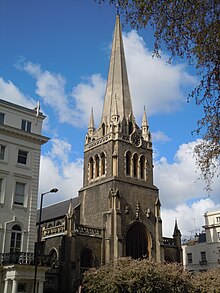St James' Church, Paddington
| St James’ Church, Sussex Gardens, Paddington | |
|---|---|

St James’ Church, Sussex Gardens, Paddington
|
|
| Coordinates: 51°30′46.8″N 0°10′35.4″W / 51.513000°N 0.176500°W | |
| Location | Paddington |
| Country | England |
| Denomination | Church of England |
| Churchmanship | Modern Catholic |
| Website | Parish website |
| History | |
| Dedication | St James the Less |
| Architecture | |
| Heritage designation | Grade II* listed |
| Architect(s) | George Edmund Street, |
| Groundbreaking | 1841 and 11 February 1882 |
| Completed | 1882 |
| Administration | |
| Parish | St James Paddington |
| Deanery | Westminster Paddington |
| Archdeaconry | Charing Cross |
| Diocese | Diocese of London |
| Province | Province of Canterbury |
| Clergy | |
| Bishop(s) | The Rt Revd Richard Chartres (Bishop of London) |
| Vicar(s) | Fr Paul Thomas |
| Assistant priest(s) | Fr Owen Dobson |
| Honorary priest(s) | Fr Martin Draper |
| Asst Curate(s) | Fr Michael Lynch |
| Laity | |
| Organist/Director of music | George de Voil |
St James' Church Paddington, also known as St James' Church Sussex Gardens, is a Church of England parish church in Paddington, London, in the United Kingdom. It is the parish church of Paddington. It is located at the western end of Sussex Gardens, a long tree-lined avenue, about 175 metres (0.109 mi) north of Hyde Park.
Until the 1840s, the parish church of Paddington was St Mary's Paddington Green. This building was too small to accommodate its burgeoning congregation, and in 1841-43 a new church, St James's, was built to accommodate the worshippers and to replace St Mary's as the parish church. The original St James's church was designed by John Goldicutt (c. 1841) but was finished by George Gutch after Goldicutt's death. Goldicutt's original scheme was for a neo-classical design in yellow brick, influenced by his travels in Italy. The yellow brick was used but Gutch changed the style to Gothic.
Within 40 years the congregation had outgrown its church building, and an enlarged church was required. The noted Gothic Revival architect G.E. Street planned extensive rebuilding, which involved retaining part of Goldicutt & Gutch's structure and remodelling the church in a 14th-century Gothic style. Unusually, Street reversed the traditional orientation of the church so that the chancel faced west rather than east, as is traditional in church architecture. Street did not live to see his plans for St James's realised as he died on 18 December 1881, before construction started. Two months after Street's death, the Princess Christian of Schleswig-Holstein laid the foundation stone for the new church on 11 February 1882. and the building work was carried out by Sir Arthur Blomfield, an associate of G.E. Street's son, A.E. Street.
...
Wikipedia
